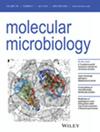Filamentation Profiling Reveals Multiple Transcription Regulators Contributing to the Differences Between Candida albicans and Candida dubliniensis.
IF 2.6
2区 生物学
Q3 BIOCHEMISTRY & MOLECULAR BIOLOGY
引用次数: 0
Abstract
Candida dubliniensis is the most closely related species to C. albicans, one of the leading causes of fungal infections in humans. However, despite sharing many characteristics, C. dubliniensis is significantly less pathogenic. To better understand the molecular underpinnings of these dissimilarities, we focused on the regulation of filamentation, a developmental trait fundamental for host colonization. We generated a collection of 44 C. dubliniensis null mutants of transcription regulators whose orthologs in C. albicans had been previously implicated in filamentous growth. These regulators are very similar at the sequence level, but phenotypic screening identified several mutants with contrasting interspecific filamentation phenotypes beyond previously known differences. Bcr1, a well-known regulator of biofilm formation, stands out as its mutant mainly showed a filamentation defect in C. dubliniensis. Phenotypic and transcriptional characterization showed that the bcr1 defect is condition dependent and that this regulator plays a central role in the filamentation of C. dubliniensis, possibly by regulating the hyphal activator Ume6. Overall, our results suggest that several regulatory pathways are involved in the filamentation differences between C. albicans and C. dubliniensis and show that the C. dubliniensis mutant collection is a valuable resource to compare, at a molecular level, these species of medical relevance.白色念珠菌和都柏林念珠菌之间的差异是由多种转录调控因子引起的。
都柏林念珠菌是与人类真菌感染的主要原因之一的白色念珠菌最密切相关的物种。然而,尽管具有许多相同的特征,但C. dubliniensis的致病性明显较低。为了更好地理解这些差异的分子基础,我们专注于丝化的调控,这是宿主定植的基本发育特征。我们收集了44个C. dubliniensis转录调节因子的零突变体,这些突变体在白色念珠菌中的同源物先前与丝状生长有关。这些调节因子在序列水平上非常相似,但表型筛选发现了几个突变体,它们具有不同的种间丝状表型,超出了先前已知的差异。Bcr1是众所周知的生物膜形成调控因子,其突变体在C. dubliniensis中主要表现为丝化缺陷。表型和转录特性表明,bcr1缺陷是条件依赖性的,并且该调节因子可能通过调节菌丝激活因子Ume6在C. dubliniensis的成丝过程中起核心作用。总的来说,我们的研究结果表明,白色念珠菌和都柏林念珠菌之间的丝状差异涉及几种调控途径,并表明都柏林念珠菌突变体收集是在分子水平上比较这些医学相关物种的宝贵资源。
本文章由计算机程序翻译,如有差异,请以英文原文为准。
求助全文
约1分钟内获得全文
求助全文
来源期刊

Molecular Microbiology
生物-生化与分子生物学
CiteScore
7.20
自引率
5.60%
发文量
132
审稿时长
1.7 months
期刊介绍:
Molecular Microbiology, the leading primary journal in the microbial sciences, publishes molecular studies of Bacteria, Archaea, eukaryotic microorganisms, and their viruses.
Research papers should lead to a deeper understanding of the molecular principles underlying basic physiological processes or mechanisms. Appropriate topics include gene expression and regulation, pathogenicity and virulence, physiology and metabolism, synthesis of macromolecules (proteins, nucleic acids, lipids, polysaccharides, etc), cell biology and subcellular organization, membrane biogenesis and function, traffic and transport, cell-cell communication and signalling pathways, evolution and gene transfer. Articles focused on host responses (cellular or immunological) to pathogens or on microbial ecology should be directed to our sister journals Cellular Microbiology and Environmental Microbiology, respectively.
 求助内容:
求助内容: 应助结果提醒方式:
应助结果提醒方式:


